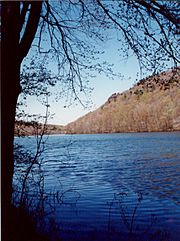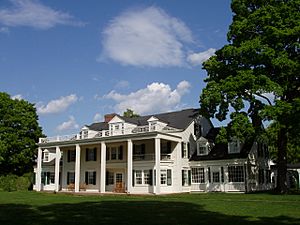Farmington Mountain facts for kids
Quick facts for kids Farmington Mountain |
|
|---|---|

Shoulder of Farmington Mountain from Farmington Reservoir
|
|
| Highest point | |
| Elevation | 502 ft (153 m) |
| Geography | |
| Location | Farmington, Connecticut |
| Parent range | Metacomet Ridge |
| Topo map | New Britain, CT |
| Geology | |
| Age of rock | 200 Ma |
| Mountain type | Fault-block; igneous |
| Climbing | |
| Easiest route | Metacomet Trail |
Farmington Mountain is a cool ridge made of a special rock called traprock. It stands about 502 feet (153 m) tall. You can find it about 9 miles (14 km) southwest of Hartford, Connecticut, in the town of Farmington.
This mountain is part of a long, narrow chain of hills called the Metacomet Ridge. This ridge stretches all the way from Long Island Sound in Connecticut, north through the Connecticut River Valley into Massachusetts, and up to the Vermont border. Farmington Mountain is special because it has unique mini-climates and rare plants. It's also home to the famous Hill–Stead Museum. A popular path called the 51-mile (82 km) Metacomet Trail runs right over Farmington Mountain.
Contents
Exploring Farmington Mountain's Shape
Farmington Mountain is about 1.4 miles (2,300 m) long and 0.5 miles (800 m) wide. It rises sharply about 250 feet (76 m) above the town of Farmington to its west. The mountain has a top ridge with two clear peaks. Below that, there's a flatter area and a ledge that sits right above the center of Farmington. This ledge connects to other nearby ridges, like Talcott Mountain to the north and Rattlesnake Mountain to the south. The Metacomet Ridge continues over these peaks.
Even though Farmington Mountain's wooded top isn't as sharp as some other peaks, it has important spots. The historic Hill–Stead Museum is on the northern part of the ridge. This museum is famous for its French Impressionist art and beautiful buildings. The southern half of the mountain has many wooded cliffs. The Farmington Reservoir is tucked away between the mountain's highest point and the lower flat area. Some parts of the mountain are also home to houses.
Water from the east side of Farmington Mountain flows into Trout Brook. From there, it goes into the Park River, then the Connecticut River, and finally reaches Long Island Sound. Water from the west side flows into the Farmington River, which also joins the Connecticut River.
How Farmington Mountain Was Made and What Lives There
Farmington Mountain, like many parts of the Metacomet Ridge, is made of basalt. This rock is also known as traprock and comes from volcanoes. The mountain formed about 200 million years ago, near the end of the Triassic Period. This was when the North American continent started to pull away from Africa and Eurasia.
During this time, hot lava pushed up from deep underground. It spread out and cooled, forming thick layers of rock. Later, huge cracks in the Earth (called faults) and earthquakes tilted these rock layers. This tilting created the steep cliffs and ridges you see on Farmington Mountain today.
The mountain has different types of environments. Hot, dry areas on the upper slopes, cool, wet valleys, and rocky ledges create special "mini-climates." These unique spots support plants and animals that are rare in other parts of Connecticut. Farmington Mountain is also a key path for raptors (like hawks and eagles) when they migrate. You can learn more about the geology and wildlife of this area by looking up the Metacomet Ridge.
The Hill-Stead Museum: A Historic Home

The Hill-Stead Museum was once a large country home on 250 acres (1.0 km2) of Farmington Mountain. It was built in 1901 for a rich businessman named Alfred Atmore Pope. His daughter, Theodate Pope Riddle, designed the house. When her parents passed away, Theodate inherited the house. Before she died in 1946, she decided to turn Hill-Stead into a museum to honor her parents. She wanted the house and everything inside it to stay exactly as it was, never to be moved, borrowed, or sold.
Today, Hill-Stead covers 152 acres (0.62 km2). The main house, called the Pope-Riddle House, is huge at 33,000-square-foot (3,100 m2). It's built in a style called Colonial-Revival. There's also an old 18th-century farm house, a garage with a theater, and other farm buildings. The house is filled with amazing paintings, prints, and art. Some highlights include works by famous artists like Édouard Manet, Claude Monet, and James McNeill Whistler. You can also see old postcards and letters from people like Mary Cassatt and Henry James.
Fun Things to Do and Protecting the Mountain
Both the Hill-Stead Museum and the town of Farmington have walking paths on the mountain. You can explore these trails and enjoy nature. The Metacomet Trail also crosses Farmington Mountain. This trail is cared for by the Connecticut Forest and Park Association. It stretches from the Hanging Hills in Meriden, Connecticut all the way to the Massachusetts border.
The walking paths at Hill-Stead Museum are free to use and you can park at the museum. They are open from 7:30 am to 5:30 pm. You can even get guidebooks to help you explore. If you want to go inside the museum, there is a fee. The museum is open from 10 am to 5 pm from May to October, and from 11 am to 4 pm from November to April.
On the southwest side of the mountain, you'll find the Farmington Reservoir Trail. The town of Farmington manages this trail. It's a great place for hiking, bird watching, picnicking, and snowshoeing. You can also get onto the Metacomet Trail from the same starting point.
The biggest threat to Farmington Mountain's unique environment and ridgeline is new buildings. In 2000, the National Park Service studied Farmington Mountain. They were looking into making a new National Scenic Trail. This new trail, now called the New England National Scenic Trail, would connect the Metacomet-Monadnock Trail in Massachusetts with the Mattabesett Trail and Metacomet Trail in Connecticut.
The Farmington Land Trust works hard to protect Farmington Mountain. They help save land on the lower parts of the mountain and nearby areas of the Metacomet Ridge.

